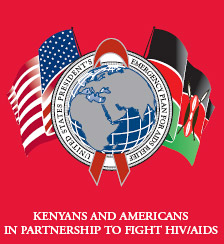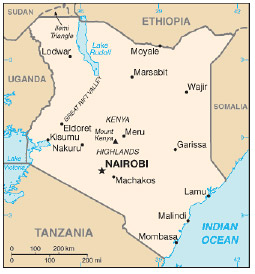| 2008 Country Profile: Kenya PDF version PDF version

 |
|
2008 Country Profile: Kenya
National HIV prevalence among adults (ages 15-49): 6.1 percent1
Adults and children (ages 0-49) living with HIV at the end of 2005: 1.3 million1
AIDS deaths (adults and children) in 2005: 140,0001
AIDS orphans at the end of 2005: 1.1 million1
Kenya is one of the Emergency Plan’s 15 focus countries, which collectively represent approximately 50 percent of HIV infections worldwide. Under the Emergency Plan, Kenya received nearly $92.5 million in Fiscal Year (FY) 2004, more than $142.9 million in FY 2005, and approximately $208.3 million in FY 2006 to support comprehensive HIV/AIDS prevention, treatment and care programs. PEPFAR is providing $368.1 million in FY 2007. | |
Recognizing the global HIV/AIDS pandemic as one of the greatest health challenges of our time, President George W. Bush announced the President’s Emergency Plan for AIDS Relief (Emergency Plan/PEPFAR) in 2003 — the largest international health initiative in history by one nation to address a single disease. The United States is changing the paradigm for development, rejecting the flawed “donor-recipient” mentality and replacing it with an ethic of true partnership. These partnerships are having a global impact and transforming the face of our world today.
Partnership to Fight HIV/AIDS
In March 2003, President Mwai Kibaki declared “total war” against HIV/AIDS. He mandated the National AIDS Control Council (NACC) to coordinate and manage the implementation of a multi-sectoral approach to HIV/AIDS, to provide policy direction, and to mobilize resources. The U.S. Government (USG) participates in the work of both NACC and the National AIDS and Sexually Transmitted Diseases Control Programme (NASCOP) of the Ministry of Health.
Specific USG responses in Kenya include:
- Making strategic investments in Kenya’s capacity to plan, secure resources for, and implement, HIV prevention, treatment, and care interventions;
- Strengthening public health and mission hospital delivery networks;
- Ensuring that Kenya’s youth have access to HIV/AIDS services;
- Expanding and expediting access to antiretroviral treatment, with special emphasis on children and those co-infected with HIV and tuberculosis or other opportunistic illnesses;
- Supporting NASCOP’s capacity to lead the establishment of comprehensive care centers offering counseling, testing, and medical management services;
- Engaging new partners and leveraging additional resources to enhance the sustainability of HIV/AIDS programs;
- Working with Government of Kenya agencies to develop and disseminate policies and guidelines on HIV counseling and testing, antiretroviral treatment, opportunistic infections, and support for orphans and vulnerable children; and
- Supporting a broad range of HIV prevention interventions including behavior change, prevention of mother-to-child HIV transmission, and improved blood collection and testing services.
| Emergency Plan Results in Kenya |
| # of individuals receiving antiretroviral treatment as of September 30, 20071 |
|
166,400 |
| # of HIV-positive individuals who received care and support in FY2007 (including TB/HIV)1 |
|
452,800 |
| # of orphans and vulnerable children (OVCs) who were served by an OVC program in FY20071 |
|
290,800 |
| # of pregnant women receiving HIV counseling and testing services for PMTCT since the beginning of the Emergency Plan1,2 |
|
2,012,000 |
| # of HIV-positive pregnant women receiving antiretroviral prophylaxis for PMTCT since the beginning of the Emergency Plan1,3 |
|
121,600 |
| # of counseling and testing encounters (in settings other than PMTCT) in FY20071 |
|
917,100 |
| # of individuals reached with community outreach HIV/AIDS prevention programs that promote Abstinence and/or Being Faithful in FY2007 |
|
3,739,600 |
| # of individuals reached with community outreach HIV/AIDS prevention activities that promote Condoms and related prevention services in FY2007 |
|
3,084,600 |
| # of USG condoms shipped from Calendar Year 2004 to 2007 |
|
40,002,000 |
|
Note: Numbers may be adjusted as attribution criteria and reporting systems are refined.
Numbers above 100 are rounded to nearest 100.
1 Total results combine individuals reached through downstream and upstream support.
2 It is possible that some individuals were counseled and tested more than once.
3 It is possible that some pregnant women received antiretroviral prophylaxis more than once over the four-year period, e.g. HIV positive women who were pregnant more than once. |
 |
Emergency Plan Achievements in Kenya to Date |
|
HIV/AIDS in Kenya Kenya has a severe, generalized HIV epidemic, but in recent years, the country has experienced a notable decline in HIV prevalence, attributed in part to significant behavioral change and increased access to ART.1 National adult HIV prevalence is estimated to have fallen from 10 percent in the late 1990s to about 6.1 percent in 2005.1, 2 Women face considerably higher risk of HIV infection than men, and also experience a shorter life expectancy due to HIV/AIDS.1 The 7th edition of AIDS in Kenya reports an HIV prevalence rate of eight percent in adult women and four percent in adult men.2 Populations in Kenya especially at risk include injecting drug users and people in prostitution, whose prevalence rates are estimated at 53 percent and 27 percent, respectively.
Challenges to Emergency Plan Implementation
Kenya is in a transitional period, with a government seeking to restructure many elements of the state. This context offers clear opportunities, but also many constraints for controlling HIV/AIDS. Human capacity development is a major concern and all partners are working to improve |
|
 |
| capabilities and human resource management systems to enable people to respond effectively to HIV/AIDS. Kenya has a large number of qualified, unemployed health care workers. The key to success will be developing effective mechanisms to engage these trained staff. In addition, efforts to employ auxiliary staff, such as adherence counselors and outreach workers, are a high priority. Treatment literacy is very low, which contributes to the high levels of stigma among health workers and the general population. Furthermore, for those who are receiving ART, systematic monitoring and evaluation is lacking.3
Critical PEPFAR Interventions for HIV/AIDS Prevention:
- Supported the national scale-up of prevention of mother-to-child HIV transmission (PMTCT) services, including supporting antiretroviral prophylaxis for HIV-positive women during a total of 121,600 pregnancies from FY2004-FY2007, and supporting training or retraining of 3,000 health workers on Ministry of Health guidelines in FY2007.
- Supported services with a network of facilities providing maternal and child health services, including early infant HIV diagnosis.
- Supported abstinence and faithfulness activities primarily targeting youth including peer education, networking, community theater, mass media programs, and curriculum-based training.
- Collaborated with the Kenya Prisons Service to set up an integrated HIV program that provides HIV prevention messages to inmates, staff and members of the surrounding community.
- Supported the Kenyan National Blood Transfusion Service and blood donor mobilizing organizations to increase blood units collected. These efforts have been bolstered through public-private partnerships to identify low risk, regular blood donors in the workplace.
Critical PEPFAR Interventions for HIV/AIDS Treatment:
- Helped to increase the availability of treatment services throughout the country by supporting new clinical sites in underserved areas.
- Coordinated with other international partners to achieve synergy between activities aimed at scaling-up access to ART.
Critical PEPFAR Interventions for HIV/AIDS Care:
- Employed community health workers to support adherence to medication regimens and to increase monitoring of those receiving assistance.
- Supported rapid and broad expansion of diagnostic counseling and testing to identify and refer for care those who are co-infected with HIV and tuberculosis.
- Supported the training, provision of supplies, and expansion of mobile counseling and testing services utilizing vans, bicycles, and even camels to reach some of Kenya’s most remote and vulnerable populations.
- Supported the provision of community-based psychosocial support to people living with HIV/AIDS.
1 UNAIDS, Report on the Global AIDS Epidemic, 2006.
2 Ministry of Health, AIDS in Kenya, 7th edition, 2005.
3 WHO, Summary Country Profile on HIV/AIDS Treatment Scale-up – Kenya, 2005. |
| |  |  |




 PDF version
PDF version